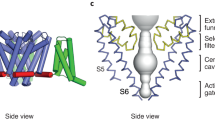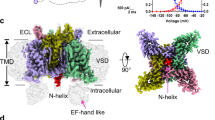Abstract
IN 1952, Hodgkin and Huxley1 proposed the now classical differential equation that has become the accepted mathematical model for describing action potentials. In this equation there are three probability factors, m, n and h, which depend on transmembrane potential and time. Conceptually these probability factors are often considered to represent three field-dependent molecular gating mechanisms that mediate ionic flow through two transmembrane channels. The m and h gates mediate sodium currents and the n gate controls potassium flow. Electrical evidence has been presented for a molecular rearrangement associated with sodium activation (for example, m gate opening)2. This evidence is based on the detection of transient electrical currents in the axon membrane which are hypothesised to represent rearrangement of molecular dipoles.
This is a preview of subscription content, access via your institution
Access options
Subscribe to this journal
Receive 51 print issues and online access
$199.00 per year
only $3.90 per issue
Buy this article
- Purchase on Springer Link
- Instant access to full article PDF
Prices may be subject to local taxes which are calculated during checkout
Similar content being viewed by others
References
Hodgkin, A. L., and Huxley, A. F., J. Physiol. Lond., 117, 500 (1952).
Armstrong, C. M., and Bezanilla, F., Nature, 242, 460 (1973).
Shapiro, B. I., Toxicon, 5, 253 (1968).
Narahashi, T., Moore, J., and Shapiro, B. I., Sciene, N.Y., 163, 680 (1969).
Hille, B., Nature, 210, 1220 (1966).
Hille, B., J. gen. Physiol., 51, 199 (1968).
Romine, W., thesis, New College, Sarasota, Florida (1973).
Lowry, O. H., Rosenbrough, N. J., Farr, A. L., and Randall, R. J., J. biol. Chem., 193, 265 (1951).
Schoepfle, G. M., Am. J. Physiol., 187, 540 (1956).
Schoepfle, G. M., Bloom, F. E., and Hellam, D., Am. J. Physiol., 193, 195 (1958).
Adam, K. R., Schmidt, H., Stampfli, R., and Weiss, C., Br. J. Pharmac., 26, 666 (1966).
Hille, B., J. gen. Physiol., 50, 1287 (1967).
Cahalan, M., Biophys. soc. Abst., 242, (1973).
Author information
Authors and Affiliations
Rights and permissions
About this article
Cite this article
ROMINE, W., SCHOEPFLE, G., SMYTHIES, J. et al. Pharmacological evidence related to the existence of two sodium channel gating mechanisms. Nature 248, 797–799 (1974). https://doi.org/10.1038/248797a0
Received:
Revised:
Issue Date:
DOI: https://doi.org/10.1038/248797a0
This article is cited by
Comments
By submitting a comment you agree to abide by our Terms and Community Guidelines. If you find something abusive or that does not comply with our terms or guidelines please flag it as inappropriate.



